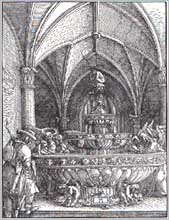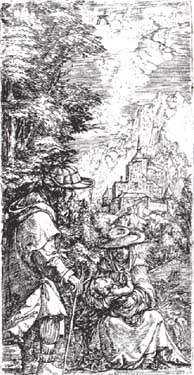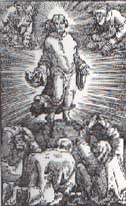Albrecht Altdorfer was born around 1480 and became an artist as much important as Albrecht Durer in Germany.
He started his artistic career under his father Ulrich who was a bourgeois from Ratisbon and reportedly studied miniature painting.

"Die Heilige Familie am Brunnen",
wood cut, 1512-1515
His first known works date from around 1507. The following year, he produced a painting for the choir of the Saint-Peter church in Ratisbon.
Altdorfer executed one of more significant paintings in 1510, Saint George in the Forest, in which he revealed himself as a master of fantasy.
Plunged in the heart of a deep forest, Saint George can be seen through an aperture between trees as he is dominating the dragon. This scenes is evoking the myth of Siegfried fighting the Fafnir dragon.

"Ruhe auf der Flucht",
copper engraving, 1515-1519
Altdorfer worked in 1511 for the convent of the Saint Florian Abbey near Linz where he produced two altar pieces dedicated to the life of that Saint.
However, he mostly worked in Ratisbon where he died in 1538.
In that city he also worked as an architect designing the ramparts and the slaughter-house and became a member of the Town-Council.
His talent as an architect was demonstrated in several paintings in which he placed architectural elements or ideal settings, notably in his painting Susan painted in 1526. In this works the figures occupy less space than the extraordinary palace which seems to be its key-element.
Altdorfer was also one of the greatest landscape painters of all times and often was Dürer's equal. He certainly had come across the works of Italian Renaissance painters and learned quickly about their techniques and ways of painting.
William IV of Bavaria ordered in 1529 what was to become his masterpiece,The Battle of Alexander, an immense piece of work where each part of the painting can be isolated and form a scene in itself (Munich Pinakothek).

wood cut, 1513
Altdorfer here showed his inclination regarding the representation of mysterious, malefic and deep forests. In fact he liked to paint the selva oscura inhabited by wild tribes showing their hostility vis-a-vis normal beings, a typical German forest where Arminius lured and defeated Augustus Roman legions, which was at the centre of fairy tales and later inspired Romantic poets and painters such as Caspar-David Friedrich during the 19th Century.
Altdorfer imposed himself as the painter of haunted forests and as a master of fantastic art beside painting religious paintings and producing stunning engravings. Still, he never met Dürer and any comparison between their works can only be explained by the fact that both originated from the same German mould and were linked to the same way of thinking in Germany during the early Renaissance period.